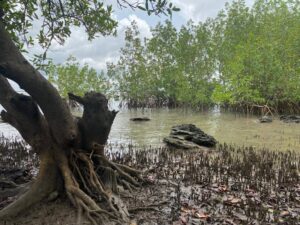Phytoplankton: uncertain future for carbon capture
The ocean is a significant carbon sink, carrier of major challenges in the evolution of global climate. Subject to climate change, its chemistry, its physics and the organisms inhabiting it find themselves greatly affected, altering its ability to capture anthropic CO2.
“Since the beginning of the industrial era, oceans absorb on average 25% of anthropic CO2 every year” states Laurent Bopp, CNRS research director at the Laboratory of Dynamic Atmosphere (LMD-IPSL). If the absorption capacity of this carbon sink is substantial, it could lessen in following decades. Several processes could explain this decline, in particular global heating affecting the solubility of CO2 in surface waters. “If we want to project the speed of climate change in the following years, we need to be able to project the way the ocean will capture carbon” he says. It becomes essential to know the amount of carbon absorbed by the ocean, and how it may evolve in the future.
To reach such an estimation, every physico-chemical and biological processes influencing the distribution of carbon in the ocean are modelled. Among them, the dynamic of the phytoplankton population plays a central part: “On the surface, and because phytoplankton photosynthetise, it absorbs atmospheric CO2 by creating organic matter composed of carbon” details Laurent Bopp. “When the organism dies, part of this matter sediments out and falls through the water column.” This mechanism, called “biological pump”, brings carbon from the surface into the deep ocean, where it remains out of contact with the atmosphere and stored for hundreds of years.
Threatened organisms
If this pump greatly influences the carbon cycle, it is itself impacted by variations in its environment. “With climate change, we know the ocean gets into strates, and this will intensify” reminds the researcher. “Yet, nutrients are mainly concentrated in deep waters. If there are less interactions between the surface and the bottom, less nutrients come back to the surface, and there is less plankton.” Plenty of other disruptions add to this phenomenon: warming and lowering of oxygen levels in surface waters, global acidification of the oceans… These modifications of marine environment threaten and alter the efficiency of the biological pump, as seen in Laurent Bopp’s modelisations: “Our results show climate change could bring a reduction in phytoplanktonic production in the following decades”.
Beyond effects of global climate, this dynamic is a threat over all of the food chain, phytoplankton composing its very basis. Yet, it remains complex to quantify its resulting effect, for several phenomena seem to partially compensate for it. Namely, the evolution of an environment entails the same for its inhabitants, selecting the species most resistant to the brutality of changes. “A great part of our research focuses on a better understanding of planktonic ecosystems, because there are many types of species with different properties. We need better insight on how this ecosystem will evolve” highlights Laurent Bopp.
Translated from Marion Barbé for IPSL





